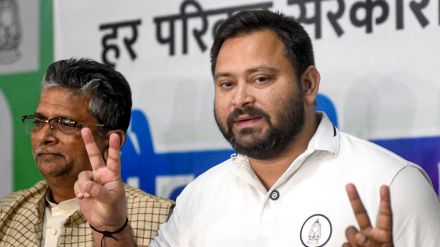Bihar‘s 2025 Exit Poll Results which predominantly forecast a win for the NDA in the state, may indicate a flip when results are declared by the ECI on November 14.
A – Exit Polls are not reliable. As we have seen in the past, they are not always accurate as the surveys rely on voters’ answers when they come out of the booth.
B – With NDA’s string of development projects vs. MGB’s promises, plus Jan Suraaj’s wildcard, a silent caste realignment or migrant vote could upend the polls. Let’s dive in :
10 reasons why exit poll results might flip
- The NDA has not clearly projected Nitish Kumar as its chief ministerial face this time and MGB named Tejashwi Yadav. Exit polls say people want Tejashwi as CM. People’s Pulse predicts a strong victory for the NDA in Bihar, but suggests that Tejashwi Yadav has a higher chance of becoming Chief Minister, with a 32% probability. In comparison, Nitish Kumar’s chances of returning as Chief Minister stand at 30%.
- Employment has been one of the biggest concerns for the states, and pitch for both NDA and MGB. Tejashwi Yadav’s ambitious promise of a government job in every household could be a key to winning polls. He had said to enact law within 20 days of government formation, further attracting the youth and first time voters’ support.
- Women could be another factor in MGB’s favor. The Rs 2,500 monthly financial assistance under ‘Maa-Bahin Yojana‘, and a lump sum of ₹30,000 on Makar Sankranti were two big schemes for women in Bihar. Assurances like this have been crucial in previous elections, and with higher turnout of women than men, the numbers could just be what the opposition need. However, NDA was not behind as it released for over 1.51 crore women in Bihar Rs 10,000 each under the Women Employment Scheme. This happened right before elections and could weaken the impact of Tejashwi Yadav’s promises.
- Caste continues to drive the politics in Bihar. One of the important sections is the Kushwaha community, which has had greater importance in ticket distribution in MGB than previous elections.
- The Jan Suraaj campaign is expected to cause losses to the NDA. Prashant Kishor comes from upper caste and though his campaign has been against both the NDA and MGB, the concerns largely remained against Nitish Kumar government as he has been in power fir 20 years.
- Mukesh Sahani, who belongs to the extremely backward Nishad community, has been promised the position of Deputy Chief Minister. The decision is a symbolic one, to attract the votes of the Nishad community. Mukesh Sahani’s Vikassheel Insaan Party (VIP) contested the election with the Mahagathbandhan, after being part of the NDA alliance last time. In the 2020 polls, it won 4 seats after allotted 11. This time, Sahani has even backed the RJD and other candidates of the MGB – a signal of unity.
- The Indian Inclusive Party, led by Indrajit Prasad Gupta, who comes from the Tanti, Tatwa, and Paan communities, has also joined the Mahagathbandhan. Through this, the alliance expects voter share from these three communities.
- In its manifesto, the NDA has promised Rs 10 lakh in financial assistance to various occupational groups within the Extremely Backward Classes (EBCs). The EBCs have been a pillar of strength for Nitish Kumar, but the opposition has spoken extensively on their poor development in 20 years, alleging misgovernance. The insurance scheme, MGB said, is an attempt to shield the shortcomings.
- On the other hand, the MGB has also pledged economic and social empowerment for the EBCs, saying it will provide ₹10 lakh each to members of different occupational groups such as Tanti, Tatma, Nishad, Mallah, Kevat, Gangota, Bind, Noniya, Teli, Tamoli, Carpenter, Dhanuk, Lohar, Kumhar, Nai, Artisan, Thathera, Mali, Chandravanshi, Halwai, Kanu, Dangi, Turha, Amat, Kevart, Rajbanshi, Gaderia, and others.
- In addition, the NDA government has announced plans to form a high-level committee headed by a retired Supreme Court judge to assess the social and economic conditions of these EBC communities and suggest measures for their empowerment. With more than 36% of Bihar’s population belonging to the EBC category, this group plays a decisive role in the state’s politics. Tejashwi Yadav’s consistent outreach—campaigning alongside Mukesh Sahani, who represents the Nishad, Mallah, and Kevat communities, and Indrajit Prasad Gupta, from the Tanti-Tatwa-Paan communities—has helped draw voter support toward the Mahagathbandhan.
